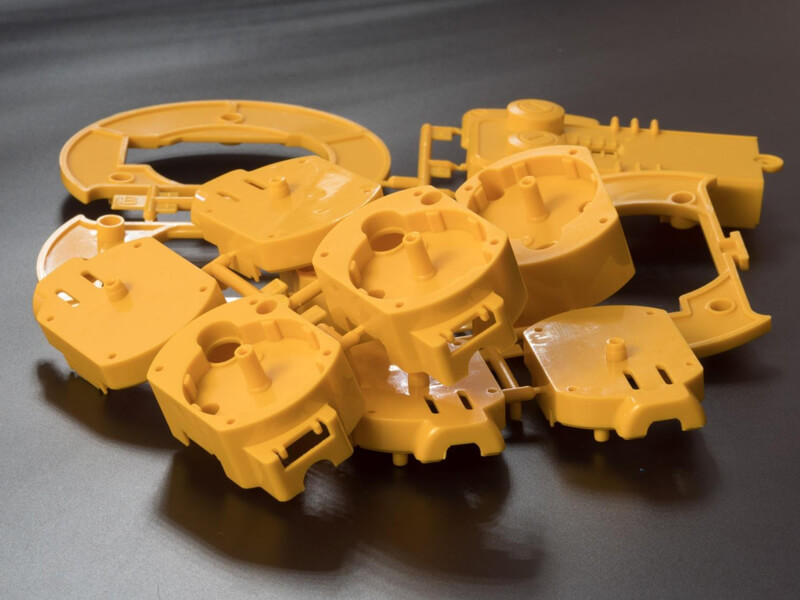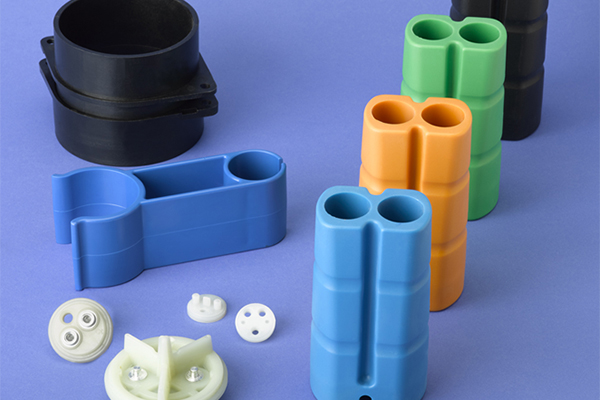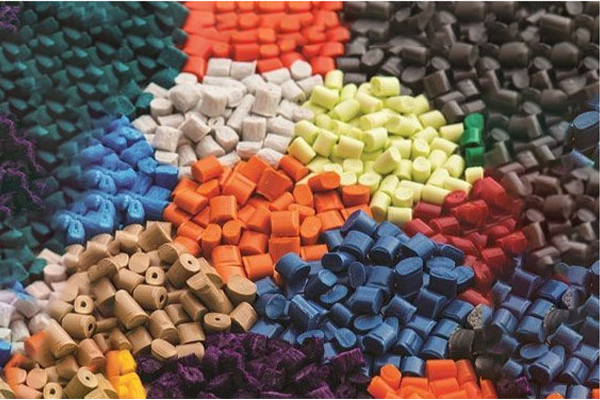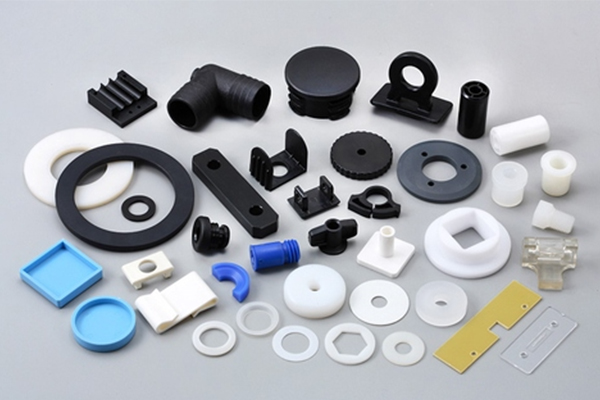Thermoplastic Injection Molding: Process and Materials
Thermoplastic injection molding is the poster child for precision and efficiency in modern manufacturing. It uses thermoplastic raw materials to create complex parts with extreme precision. The molding process leverages cutting-edge mechanical and design expertise to produce the same high-quality products in batches while minimizing waste. Thermoplastic injection molding’s focus on precision, efficiency and innovation is an indispensable force in shaping future products and innovations.
As a top Chinese plastic molder, Sungplastic has gained rich plastic part manufacturing experience in prototyping and injection molding processes of various plastic material accessories. Are you looking for a plastic manufacturing supplier? We will be your excellent partner.

What is Thermoplastic?
Thermoplastic is a type of polymer material characterized by it ability to soften and become malleable when heated and then solidify again upon cooling, all without undergoing irreversible chemical changes. This unique property makes thermoplastics highly versatile in manufacturing processes. They can be melted, molded, and reshaped multiple times, making them recyclable and environmentally friendly. With a wide range of properties and applications, thermoplastics are used in diverse industries, including automotive, packaging, electronics, construction, and healthcare. Common materials include polyethylene, polypropylene, PVC, and PET. The ease of processing, flexibility, and recyclability of thermoplastics contribute to their widespread use in modern production and design.
What is Thermoplastic Injection Molding?
Thermoplastic injection molding is a high-precision, high-efficiency manufacturing process used to create complex plastic parts. The process involves heating a thermoplastic material to its melting point and then injecting it into a mold cavity under high pressure. Once in the mold, the material cools and solidifies there to form the precise shape inside the mold. This method allows for the large-scale production of complex, consistent and durable plastic parts with exceptional precision. It is used in a wide range of industries, including automotive, electronics, medical and consumer goods, for its ability to produce high-quality parts quickly and cost-effectively. What’s more, it is the industry standard for manufacturing plastic parts, so manufacturers adopting this process can ensure the production of high-quality plastic products.
Benefits of Thermoplastic Molding
To ensure high-quality part production, selecting the appropriate material for thermoplastic injection molding imparts the sturdiness and mechanical characteristics of mass-produced components. This renders it well-suited for conducting tests and small-scale marketing runs. The molds themselves yield outstanding product quality, and the versatility of injection molding or thermoplastic injection allows for the use of molds ranging from very small to extremely large, all while maintaining remarkable precision. This versatility explains its widespread use in rapid prototyping within the medical and automotive sectors, where stringent quality and performance standards are imperative.

Thermoplastic Injection Molding Process
The thermoplastic injection molding process is a highly precise, efficient and versatile manufacturing method used to create high-quality plastic parts and components with complex designs and tight tolerances. It mainly involves the following critical stages:
Plastic Part Design:
-
- Design Guidelines: Successful injection molding design follows specific guidelines. These include designing parts with uniform wall thickness to ensure even cooling and minimizing warping. Fillets and radii should be used to avoid sharp corners, and ribs may be incorporated for added strength.
- Draft Angle: Draft angles, typically 1 to 2 degrees, are incorporated into the design to facilitate easy ejection of the part from the mold. Without draft angles, parts may become stuck in the mold.
- Wall Thickness: Consistent wall thickness is essential to prevent defects like sink marks and warping. Uniform thickness ensures even cooling during the molding process.
- Undercuts: Avoiding undercuts (areas where the part features angles or surfaces that prevent easy ejection) is crucial unless complex mechanisms are used to release the part.
Injection Molding Tool Manufacturing:
-
- Mold Design: The mold design phase involves creating a detailed plan for the mold, specifying the shape and features of both the part and the mold cavity. It includes considerations for parting lines, gating systems, and cooling channels.
- Mold Type: Depending on the complexity and production volume of the part, different mold types may be used, such as single-cavity molds for low volume or multi-cavity molds for high volume production.
- Mold Processing: The mold itself is manufactured using precision machining techniques like CNC milling or electrical discharge machining (EDM). Cooling channels are integrated to regulate temperature during production.
Injection Molding:
-
- Temperature Control and Melting: Thermoplastic pellets or granules are fed into the injection molding machine’s hopper, where they are heated to their melting point. Temperature control is critical to achieve the correct melt viscosity.
- Injection: The molten thermoplastic material is injected into the mold cavity under high pressure using a reciprocating screw or plunger. Injection pressure ensures the material fills the mold completely and replicates the part’s shape.
- Cooling: After injection, the mold is cooled to allow the material to solidify and take on the desired shape. Proper cooling control is vital to prevent warping or shrinkage.
- Ejection: Once the part has cooled and solidified, the mold opens, and ejector pins or plates push the part out of the mold cavity. The part is then removed and prepared for additional processing or assembly.
Material Used in Thermoplastic Injection Molding
Thermoplastic injection molding uses a wide range of plastic materials, each with its unique properties and applications. The choice of material depends on factors such as the desired characteristics of the finished part, its intended use, environmental considerations, and cost. Some common materials used in thermoplastic molding include:
-
- Polyethylene (PE):
Known for its low cost and excellent chemical resistance, polyethylene is used in various applications, including packaging, containers, and toys. It comes in different types, such as low-density polyethylene (LDPE) and high-density polyethylene (HDPE). - Polypropylene (PP):
PP is versatile and widely used in automotive parts, consumer goods, and packaging. It offers good chemical resistance and is known for its toughness and rigidity. - Polyvinyl Chloride (PVC):
PVC is known for its durability, electrical insulation properties, and resistance to chemicals and weathering. It’s used in pipes, cable insulation, and a wide range of consumer products. - Polystyrene (PS):
PS is lightweight and commonly used for packaging materials, disposable cutlery, and consumer goods. It comes in two main forms: general-purpose polystyrene (GPPS) and high-impact polystyrene (HIPS). - Polycarbonate (PC):
PC is valued for its exceptional impact resistance and optical clarity. It’s used in eyewear lenses, automotive components, and electronics. - Acrylonitrile-Butadiene-Styrene (ABS):
ABS is a versatile thermoplastic with good impact resistance and dimensional stability. It’s used in automotive parts, electronics, and consumer products. - Nylon (Polyamide):
Nylon is known for its strength, toughness, and resistance to wear. It’s used in mechanical parts, gears, and bearings. - Polyethylene Terephthalate (PET):
PET is commonly used for beverage bottles and food packaging due to its transparency, strength, and recyclability. - Polyurethane (PU):
PU is a flexible and durable material used in the production of foam cushions, footwear, and various industrial components. - Polyoxymethylene (POM):
POM, also known as acetal, is a high-strength thermoplastic often used in precision parts, gears, and bearings due to its low friction and excellent dimensional stability. - Thermoplastic Elastomers (TPEs):
TPEs combine the properties of rubber and plastics, offering flexibility, resilience, and chemical resistance. They are used in automotive seals, medical devices, and consumer products.
- Polyethylene (PE):

Limitations of Thermoplastic Injection Molding
As previously mentioned, every manufacturing process comes with its set of advantages and disadvantages. Let’s take a closer look at some of the drawbacks associated with it:
-
- Cost: One of the primary drawbacks of this process is its cost. The initial investment required for tooling and mold creation can be quite expensive. Manufacturers must bear these upfront tooling expenses.
- Speed: While we highlighted “speed” as an advantage of thermoplastic injection molding, whether it is a pro or con depends on the specific application. For instance, when used for early prototypes, speed can be considered a disadvantage. This is because, compared to other prototyping methods like 3D printing, thermoplastic molding is a slower and more costly process. In contrast, 3D printing can produce one-off parts in a matter of hours, whereas thermoplastic injection molding may take several days due to the involvement of tooling.
- Defects: Similar to other production methods, thermoplastic injection molding can yield defective parts. These defects may arise from various factors, including issues with the tooling, using thermoplastic resin materials at incorrect temperatures, improper injection speeds (either too fast or too slow), insufficient venting in the tooling and inadequate cooling around the tool.
Thermoset Molding Vs. Thermoplastic Injection Molding
Thermoset molding and thermoplastic injection molding are two distinct processes used in the manufacturing of plastic parts and components. Thermoset molding and thermoplastic injection molding serve different purposes based on the material characteristics and application requirements. Thermoset molding offers durability and resistance, while thermoplastic injection molding provides versatility, recyclability, and ease of processing. The choice between the two depends on specific project needs and material properties. Below, we introduce the key differences between the two in terms of materials, characteristics, applications and recyclability:
Material
-
- Thermoset Molding: In thermoset molding, the material used is thermosetting plastic. Thermosetting plastics are initially soft and malleable when heated but undergo a chemical reaction during curing (cross-linking) that irreversibly hardens them. Once cured, they cannot be melted or reprocessed. This makes them highly durable and resistant to heat, chemicals, and electrical insulating properties.
- Thermoplastic Injection Molding: It employs thermoplastic materials. These materials become soft and pliable when heated but solidify upon cooling without undergoing chemical changes. They can be melted, molded, and reshaped multiple times, making them recyclable and versatile.
Process Characteristics
-
- Thermoset Molding: Thermoset molding involves a curing process where the material is heated and undergoes a chemical reaction, hardening into its final form. Once cured, it cannot be melted or reworked, limiting its recyclability.
- Thermoplastic Injection Molding: It entails melting thermoplastic pellets or granules, injecting them into a mold, cooling to solidify the material, and ejecting the finished part. This process can be repeated, allowing for reprocessing and recycling of materials.
Applications
-
- Thermoset Molding: Thermoset plastics are preferred for applications requiring high heat resistance, electrical insulation, and chemical resistance. Common uses include electrical insulators, automotive components, and aerospace parts.
- Thermoplastic Injection Molding: It is versatile and widely used across various industries due to its recyclability, ease of processing, and ability to produce intricate parts. Applications include consumer goods, packaging, automotive components, medical devices, and more.
Recyclability
-
- Thermoset Molding: Thermosetting plastics cannot be recycled through melting and reprocessing due to their irreversible curing process.
- Thermoplastic Injection Molding: Thermoplastics can be recycled by melting and reshaping, making them more environmentally friendly.
Applications of Thermoplastic Molding
Thermoplastic injection molding is widely used in various industries due to its versatility, precision, and efficiency. Here are specific applications of thermoplastic injection molding in different sectors:
Automotive Industry
-
- Interior Components: Injection molding produces dashboard panels, door handles, interior trim, and other components due to its ability to achieve intricate designs and high-quality surface finishes.
- Exterior Parts: Thermoplastics are used for exterior parts like bumpers, grilles, and side mirrors due to their impact resistance and lightweight properties.
- Engine Components: Thermoplastic injection molding creates engine components like air intake manifolds and fuel system parts, which require heat resistance and precision.
Packaging Industry
-
- Bottles and Containers: Thermoplastic injection molding produces plastic bottles, containers, and caps for food, beverages, cosmetics, and household products.
- Packaging Inserts: Molded inserts provide cushioning and protection for fragile items within packaging.
Electronics Industry
-
- Connectors and Housings: Injection molding is used to create connectors, cable housings, and cases for electronic devices due to its electrical insulating properties and precision.
- Keyboard Keys: Computer and device keyboard keys are often made using thermoplastic injection molding.

Medical Industry
-
- Medical Devices: Thermoplastic materials are used to produce various medical devices, including syringes, IV components, and surgical instruments, due to their biocompatibility and ease of sterilization.
- Lab Equipment: Laboratory equipment such as pipettes and vials are manufactured using injection molding.
Consumer Goods Industry
-
- Toys: Injection molding produces plastic toys, action figures, and figurines with intricate details.
- Household Items: Items like kitchen utensils, storage containers, and consumer electronics housings are made using this method.
- Sporting Goods: Many sporting goods, including golf balls, hockey pucks, and bicycle helmets, are manufactured with thermoplastic injection molding.
Aerospace Industry
-
- Interior Components: Injection molding is used to create lightweight and durable interior components such as seat components and interior panels.
- Ducting and Ventilation: Air ducts and ventilation components benefit from the precision and heat resistance of thermoplastics.
Construction Industry
-
- Pipe Fittings: Thermoplastic injection molding produces pipe fittings and connectors used in plumbing and irrigation systems.
- Construction Fasteners: Components like wall anchors and fasteners are made with this method due to their durability.
Industrial Manufacturing
-
- Machine Parts: Injection molding creates custom machine components and parts used in various manufacturing processes.
- Safety Equipment: Industrial safety equipment, such as hard hats and safety goggles, are manufactured with the molding.
Why Use Sungplastic for Molding & Manufacturing?
With over two decades of manufacturing and engineering experience, Sungplastic has deep expertise in the injection molding field. During our manufacturing process, we encounter and successfully solve a variety of challenges in product and part manufacturing. At the same time, in terms of thermoplastic injection molding process, Sungplastic can provide valuable insights into optimizing the injection molding solutions for your product, saving time and money while ensuring a successful outcome.
Get a free quote and design analysis today.
We’ll reply to you within 6 working hours.
We respect your privacy.
+86 139 2927 4777 (WhatsApp, Wechat)
